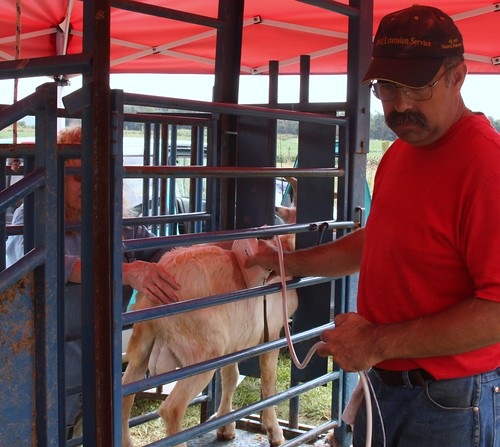Jaw defects are inherited and males with significant abnormalities should be culled. Each goat was mouthed to determine the correctness of its bite. Over and underbites were measured. None of the bucks in the test had severe jaw abnormalities.
A buck that is not structurally sound has no place in a breeding program. The goats were evaluated, both while they were standing and while on the move, to determine structural correctness. Feet, legs, pasterns, and hooves were evaluated. Only one buck failed to meet the minimum standards for structural correctness. He had severe hoof problems.
 Teats were counted. While breeders have varying opinions regarding multiple teats, a buck with two teats is usually considered most desirable. Cluster teats and fishtail teats are reasons for disqualification in most breeds. The teat structure of each goat was evaluated and abnormalities were noted. No goats were disqualified for teat number or structure.
Teats were counted. While breeders have varying opinions regarding multiple teats, a buck with two teats is usually considered most desirable. Cluster teats and fishtail teats are reasons for disqualification in most breeds. The teat structure of each goat was evaluated and abnormalities were noted. No goats were disqualified for teat number or structure.
A metal scrotal tape was used to determine the scrotal circumference (SC) of each buck. The testicles were measured at their widest part. In other species, scrotal size is related to libido (sex drive) and fertility. There is also a correlation between scrotal size and the fertility of the male's daughters.
For the sixty goats on test, scrotal circumference ranged from 15 to 27.5 centimeters (6 to 11 inches) and averaged 22.8 centimeters (9.1 inches). As would be expected, larger and older bucks tended to have larger scrotums.
 Scrotal circumference is a highly heritable trait (50%). Unfortunately, the goat industry has not established standards for scrotal circumference. As a result, no bucks were disqualified for having small scrotums. The goat with the largest scrotal size (27.5 cm) was a 68-lb. Kiko buck consigned by Wes Pinneo (KS).
Scrotal circumference is a highly heritable trait (50%). Unfortunately, the goat industry has not established standards for scrotal circumference. As a result, no bucks were disqualified for having small scrotums. The goat with the largest scrotal size (27.5 cm) was a 68-lb. Kiko buck consigned by Wes Pinneo (KS).
Splits in the scrotum were measured. Unusually large splits (over 2 inches/50 mm) are considered undesirable. A buck with a scrotal split can still get does pregnant, but it is not a desirable trait to pass along to the next generation. No goats were disqualified for having unusually large splits.
Jim Pritchard from West Virginia University scanned the goats to determine their back fat thickness (BF) and rib eye area (REA). Back fat ranged from 0.03 to 0.10 inches and averaged 0.043 inches. Rib eye area ranged from 0.6 to1.7 square inches and averaged 1.1 square inches. The goat with the largest REA (1.7 sq. in.) was a 66-lb. Kiko buck consigned by Craig Adams (IL).
Rib eye data are actual and were not adjusted for anything. As with scrotal size, larger bucks tended to have larger rib eye areas. Rib eye area is a moderately heritable trait in other species (40-45%).
Rib eye area (square inches)













